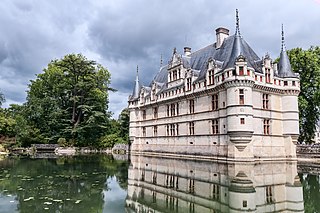
The Loire Valley, spanning 280 kilometres (170 mi), is a valley located in the middle stretch of the Loire river in central France, in both the administrative regions Pays de la Loire and Centre-Val de Loire. The area of the Loire Valley comprises about 800 square kilometres (310 sq mi). It is referred to as the Cradle of the French and the Garden of France due to the abundance of vineyards, fruit orchards, and artichoke, and asparagus fields, which line the banks of the river. Notable for its historic towns, architecture, and wines, the valley has been inhabited since the Middle Palaeolithic period. In 2000, UNESCO added the central part of the Loire River valley to its list of World Heritage Sites.
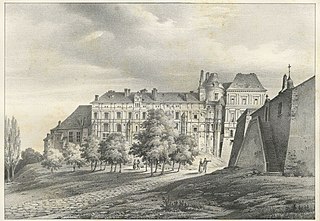
The Royal Château of Blois, is located in the city center of Blois, Loir-et-Cher, in the Loire Valley, France. In addition to have been the residence of the Counts of Blois and some French Kings, Joan of Arc also went there by 1429 to be blessed by the Archbishop of Reims before departing with her army to drive against the English, who conquered Orléans the previous year.
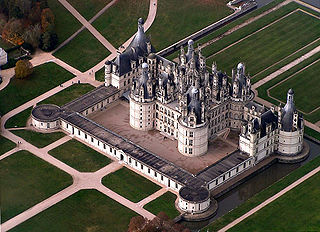
The Château de Chambord in Chambord, Centre-Val de Loire, France, is one of the most recognisable châteaux in the world because of its very distinctive French Renaissance architecture which blends traditional French medieval forms with classical Renaissance structures. The building, which was never completed, was constructed by Francis I.

The Château du Clos Lucé, formerly called Manoir du Cloux, is a large château located in the center of Amboise, in the department of Indre-et-Loire, in the Centre-Val de Loire region of France. It is located in the natural Val de Loire region. Built by Hugues d'Amboise in 1471, the palace has known several famous owners such as the French king Charles VIII and Leonardo da Vinci. Clos Lucé is 500 metres from the royal Château d'Amboise, to which it is connected by an underground passageway.

Stairs are a structure designed to bridge a large vertical distance by dividing it into smaller vertical distances, called steps. Stairs may be straight, round, or may consist of two or more straight pieces connected at angles.

Valençay is a commune in the Indre department in the administrative region of Centre-Val de Loire, France.

Altenburg is a city in Thuringia, Germany, located 40 kilometres south of Leipzig, 90 kilometres west of Dresden and 100 kilometres east of Erfurt. It is the capital of the Altenburger Land district and part of a polycentric old-industrial textile and metal production region between Gera, Zwickau and Chemnitz with more than 1 million inhabitants, while the city itself has a population of 33,000. Today, the city and its rural county is part of the Central German Metropolitan Region.

Schwerin Castle, is a schloss located in the city of Schwerin, the capital of Mecklenburg-Vorpommern state, Germany. It is situated on an island in the city's main lake, Lake Schwerin.
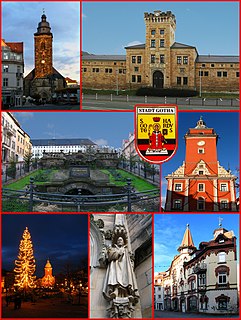
Gotha is the fifth-largest city in Thuringia, Germany, 20 kilometres west of Erfurt and 25 km east of Eisenach with a population of 44,000. The city is the capital of the district of Gotha and was also a residence of the Ernestine Wettins from 1640 until the end of monarchy in Germany in 1918. The House of Saxe-Coburg and Gotha originating here spawned many European rulers, including the royal houses of the United Kingdom, Belgium, Portugal and Bulgaria.

Renaissance Revival architecture is a group of 19th century architectural revival styles which were neither Greek Revival nor Gothic Revival but which instead drew inspiration from a wide range of classicizing Italian modes. Under the broad designation Renaissance architecture nineteenth-century architects and critics went beyond the architectural style which began in Florence and Central Italy in the early 15th century as an expression of Renaissance humanism; they also included styles that can be identified as Mannerist or Baroque. Self-applied style designations were rife in the mid- and later nineteenth century: "Neo-Renaissance" might be applied by contemporaries to structures that others called "Italianate", or when many French Baroque features are present.

Chambord is a commune in the Loir-et-Cher department, region of Centre-Val de Loire. In 2018, it had a population of 93. It is best known for its Château de Chambord, part of the Loire Valley UNESCO World Heritage Site.

The Château de Sully-sur-Loire is a castle, converted to a palatial seigneurial residence, situated in the commune of Sully-sur-Loire, Centre-Val de Loire, France.

French Renaissance architecture is a style which was prominent between the late 15th and early 17th centuries in the Kingdom of France. It succeeded French Gothic architecture. The style was originally imported from Italy after the Hundred Years' War by the French kings Charles VII, Louis XI, Charles VIII, Louis XII and François I. Several notable royal châteaux in this style were built in the Loire Valley, notably the Château de Montsoreau, the Château de Langeais, the Château d'Amboise, the Château de Blois, the Château de Gaillon and the Château de Chambord, as well as, closer to Paris, the Château de Fontainebleau.

The architecture of Germany has a long, rich and diverse history. Every major European style from Roman to Postmodern is represented, including renowned examples of Carolingian, Romanesque, Gothic, Renaissance, Baroque, Classical, Modern and International Style architecture.
Schloss Lieser in the Mosel valley nearby Bernkastel-Kues is one of the most striking buildings within the village of Lieser, Germany. The building currently houses a 49-room Autograph Hotel, called Schloss Lieser, Autograph Collection.

Bergfried is a tall tower that is typically found in castles of the Middle Ages in German-speaking countries and in countries under German influence. Friar describes it as a "free-standing, fighting-tower". Its defensive function is to some extent similar to that of a keep in English or French castles. However, the characteristic difference between a bergfried and a keep is that a bergfried was typically not designed for permanent habitation.

The Château d'Azay-le-Rideau is located in the town of Azay-le-Rideau in the French département of Indre-et-Loire. Built between 1518 and 1527, this château is considered one of the foremost examples of early French renaissance architecture. Set on an island in the middle of the Indre river, this picturesque château has become one of the most popular of the châteaux of the Loire valley.

The Château de Meung-sur-Loire is a former castle and episcopal palace in the commune of Meung-sur-Loire in the Loiret département of France.
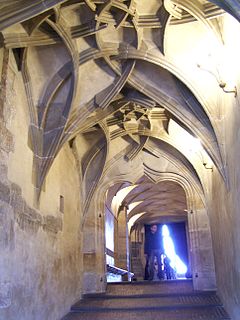
An equestrian staircase or riders' staircase is a very gently sloping flight of steps that can be negotiated by horses. Its origins may be seen in the mule staircases in steep terrain in open country.

Beauregard Castle is a ruined castle on the territory of Chippis in the canton of Valais, Switzerland. It is situated on a rocky spur at the entrance to the Val d'Anniviers.




















